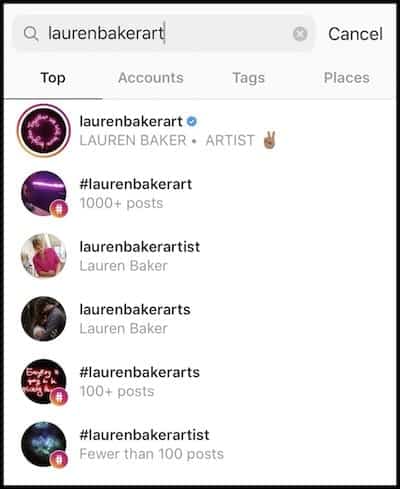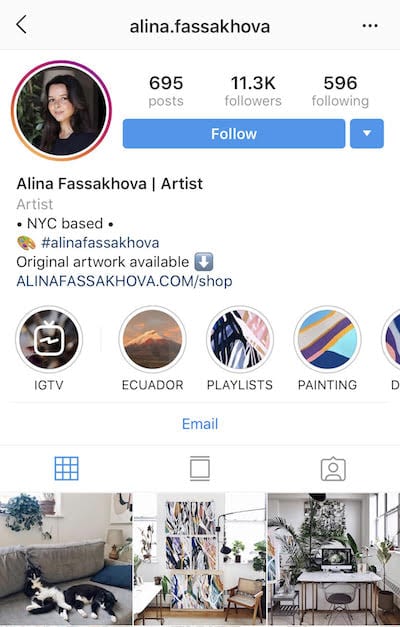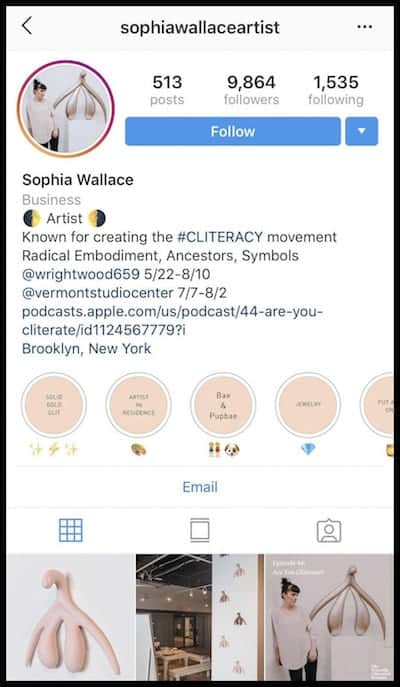A well-designed Instagram strategy to engage art collectors should be part of every artist’s marketing plan. Without one, you may struggle to grow your following beyond your friends or family. You may have many followers but fail to reach art collectors. Or, you may post mainly about your creative process and have an artist following interested in learning about your work, but not interested in purchasing it. Bottom line, if you want to attract current and potential art collectors and buyers to your Instagram, you need a specific strategy to reach them.
1. Define Your Instagram’s Purpose
In order to attract art collectors, first decide on the purpose of your Instagram. Do you want to become famous, build a community of artist friends, make money from sales, reach museums, critics, the press, or purely as a portfolio to share what you love? You don’t have to limit yourself to only one purpose, but it’s good to list them in order of priority because this will have a big impact on how you use Instagram. Before you make a decision, ask yourself, is my decision addressing my target audience of art collectors and potential buyers?
For artists with gallery representation or an established career, Instagram may not necessarily be a tool for sales but a platform to further your reputation, cultivate partnerships, and communicate with fans. However, for artists who are starting out, Instagram can be key in establishing your career, reaching collectors, finding galleries, and making your first sales.
2. Capture Yourself at a Glance
Your Instagram profile is a new type of visual resume that lives online and can be updated instantly. Once an art collector discovers your work through a post and comes to your page, you only have a few seconds to capture their attention. Make it easy for them with this checklist.
Your Instagram Profile should include:
A catchy handle name with your full professional name. It also doesn’t hurt to have the word ‘art’ or ‘artist’ in your handle name or in your profile name so it shows up on a search preview. Take a look at @laurenbakerart and @alina.fassakhova for great examples.
- A recognizable profile picture. It doesn’t have to be your face. It could be a logo, but it has to be consistent throughout your social media platforms. @sophiawallaceartist did a great job showing her art and a snapshot of herself, which allows you to recognize her both on Instagram and at a gallery opening.
- A short description of who you are and what you do. A good rule of thumb is to say a little about yourself and a little about your art practice. (Like “A vegan London-based artist creating sound installations with recycled wood.) Here’s where you want to include the word ‘artist’ in your description. It’s going to help people search for you.
- A website. This is surprisingly important today despite the prevalence of social media. Having one gives you credibility.
- How to contact you. Make sure you provide contact methods that you check regularly, whether it’s email, Instagram message, etc.
Once you play around with the above checklist, search for yourself on a friend’s Instagram. See how easy it is to find your feed and if you like how your profile looks to another user: you.
3. Maximize Story Highlights
If someone discovers your art through a post and is intrigued by your bio, the next thing they usually do is watch your Instagram Highlights. This is where you get to tell your story, show your personality, show your accomplishments, and get followers. Unlike regular Instagram Stories that disappear after 24 hours, Instagram Story Highlights can live permanently on your profile.
Instagram Story Highlight Ideas:
- Bio/ Who Am I
- Studio Visits
- Past Shows
- Artworks in a Collection or Exhibition
- Materials and Process
4. Try ‘Creator Account’
Instagram used to only have two types of accounts–personal and business, which did not really address the needs of artists and creators. Luckily for artists, Instagram recently launched a Creator Account, designed to tap into user data and better connect with your audience. You can filter direct messages and get more in-depth analytics to understand your followers. Most artists are still testing it out, but since it’s easy to switch back to a personal or business account, it doesn’t hurt to give it a try.
5. Audit Your Visual Content
This is an easy one as most artists are visual geniuses and do not need any tips on how to display and showcase their work. However, you need to be able to be your own curator and edit your content.
 Content that art collectors look for:
Content that art collectors look for:
- Good pictures of your artwork with great lighting. A picture with bad lighting shows that you don’t take your work seriously and neither should a prospective art buyer.
- Different perspectives of your artworks. Closeups, long shots and details to make the work come to life.
- Posts of your artworks photographed in homes or in art collections. It’s important for buyers to see how your art looks in a non-studio or gallery setting. It’s okay if you’ve never sold or exhibited before, just display your art at a friend’s home or even at a cafe (ask permission first) and take a professional shot of it. There are also online editing tools that place your artworks in virtual gallery settings.
6. Show Your Values
Art collectors want to know about you as much as your art. Don’t be shy about showing who you are as a person – strategically. It’s very powerful these days when an artist expresses their opinions on social issues that are important to them. Buying art is like making a new friend and inviting that friend to your home. The more you share about what you stand for, the more comfortable and excited an art collector will feel purchasing your work.
One great way to do this is of course through videos on IGTV or Instagram Stories. If you’re

great at speaking, this will be a powerful way to engage your followers and potential collectors. It’s okay if you’re camera shy though! Post words, quotes, and stories that inspire you and share your views on current events. We are all gifted in different ways and you should explore what medium amplifies your voice most powerfully.
7. Have Fun with It
Besides your social values, there are also other ways to show art buyers who you are as a person and what makes you unique. This could be posts about your daily routines, your family, your skateboarding experiences, your trip to Peru, or your pet! Many artists are recognized for their style. If fashion is important to you, show your followers what you wear in your studio, during gallery visits, or when you hang out with friends. Just make sure the photos are high quality, well-composed and engaging. Even though these images are not of art for sale, they reflect and reinforce your visual aesthetic and professionalism. Buying art is a very personal journey for an art collector. They want to feel like they’re making friends with someone they admire or can relate to.
8. Be Open About Sales
Be open about the fact that your art is for sale. Most buyers have no idea how the art world works and are too afraid to ask, even if they have the ability and desire to buy art. I’ve seen on many occasions that people with disposable income chose to buy a print or poster from furniture stores because they had no idea they could buy directly from living artists. Being more open about selling your art on Instagram is not only beneficial to you but also buyers who are looking for art and have no idea where to go and are looking for a personal connection to the artist.
This can be very simple. Tell your followers in a casual way where and how they can buy your art, whether it’s on your Etsy, Instagram Shop, Artrepreneur, or simply through your own website. It can be scary, but once you get used to putting yourself out there, you’ll start to enjoy the process. Experiment with small sales tactics by advertising the fact that you will sell small prints or take commissions during holiday times for people who are looking for unique gifts. Once a buyer starts engaging with you in small ways, they will feel more comfortable to make bigger purchases and to recommend you.
Just remember, no one will know about your art unless you tell them. Let the world know what you’re doing and selling on Instagram, and art collectors will follow.
